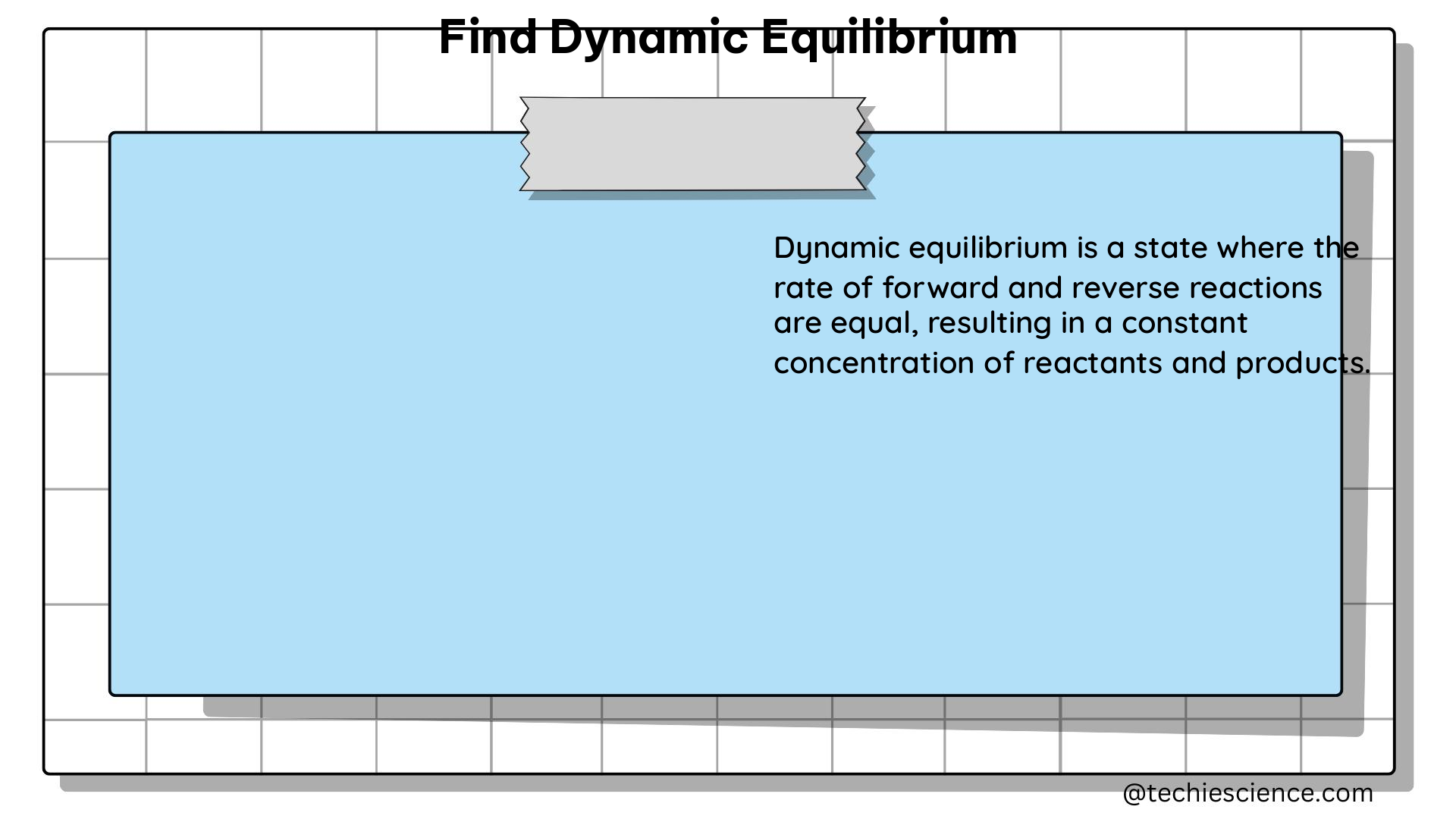Dynamic equilibrium is a fundamental concept in physics, chemistry, and various other fields, describing a state where two opposing processes occur at equal rates, resulting in no net change in the system. This comprehensive guide will delve into the intricacies of dynamic equilibrium, providing a detailed understanding of its principles, applications, and real-world examples.
Understanding Dynamic Equilibrium
Dynamic equilibrium is a state where the rate of the forward reaction and the rate of the reverse reaction are equal, leading to a constant concentration of reactants and products over time. This concept is often contrasted with static or thermodynamic equilibrium, where the system has reached a state of minimum free energy and there is no net change in the system.
The Equilibrium Constant (Kc)
In chemistry, dynamic equilibrium is often described using the equation:
Kc = [Cproducts] / [Creactants]
Where:
– Kc is the equilibrium constant
– [Cproducts] is the concentration of the products
– [Creactants] is the concentration of the reactants
The equilibrium constant is a measure of the rate of the forward reaction relative to the reverse reaction, and it is constant for a given reaction at a specific temperature. The value of Kc can provide insights into the direction of the equilibrium:
- If Kc > 1, the equilibrium favors the products.
- If Kc < 1, the equilibrium favors the reactants.
- If Kc = 1, the equilibrium is equally balanced between reactants and products.
Factors Affecting Dynamic Equilibrium
The dynamic equilibrium of a system can be influenced by various factors, such as:
- Concentration: Increasing the concentration of reactants or products will shift the equilibrium in the direction that reduces the concentration of the added species, as per Le Chatelier’s principle.
- Temperature: Changes in temperature can affect the equilibrium constant (Kc) and shift the equilibrium position.
- Pressure: In gas-phase reactions, changes in pressure can shift the equilibrium position, as per Le Chatelier’s principle.
- Catalysts: Catalysts can affect the rates of the forward and reverse reactions, but they do not change the equilibrium position.
Dynamic Equilibrium in Physics

In physics, dynamic equilibrium can be observed in various systems, where the balance between opposing forces or processes results in a stable state.
Pendulum Motion
Consider a simple pendulum, where the force of gravity and the tension in the string balance each other, causing the pendulum to swing back and forth at a constant amplitude. This is an example of dynamic equilibrium, where the potential energy and kinetic energy of the pendulum are constantly exchanged, maintaining a stable oscillation.
Electrical Circuits
Another example of dynamic equilibrium in physics is the flow of electricity in a circuit. The current in the circuit is determined by the balance between the resistance in the circuit and the voltage applied to it. This balance results in a steady flow of electrons, maintaining a constant current.
Dynamic Equilibrium in Wellbeing
In the context of wellbeing, dynamic equilibrium can be seen as a state where an individual experiences a balance between positive and negative events, and their subjective well-being (SWB) remains relatively stable over time.
Cummins’ Theory of Homeostasis
Cummins’ theory of homeostasis suggests that individuals have a set-point range for SWB, and they tend to return to this range after experiencing life events. According to this theory:
- When an individual experiences no challenge, SWB stays at the set-point.
- When an individual experiences mild challenge, the level of SWB will vary slightly within the set-point range.
- When an individual experiences a strong challenge, homeostatic defenses prevent SWB from decreasing below the set point.
This dynamic equilibrium in wellbeing helps individuals maintain a relatively stable level of subjective well-being despite the ups and downs of life.
Dynamic Equilibrium in Watershed Health
In the context of watershed health, dynamic equilibrium refers to a state where sediment size and volume are in balance with stream slope and discharge. This natural balance is maintained through the interactions between watershed inputs (water, sediment, and organic matter) and valley characteristics (valley slope and width, bedrock and surficial geology, soils, and vegetation).
Disturbances and Equilibrium Restoration
Disturbances, such as floods or forest fires, can cause a stream to become unbalanced. However, the stream will seek equilibrium conditions through the adjustment of its various components until it is once again in a form that allows it to efficiently perform its functions of water and sediment discharge.
Conclusion
Dynamic equilibrium is a fundamental concept that spans various fields, including physics, chemistry, and wellbeing. Understanding the principles of dynamic equilibrium, the factors that influence it, and its real-world applications is crucial for a comprehensive understanding of these systems. This guide has provided a detailed exploration of dynamic equilibrium, equipping you with the knowledge and tools to navigate this important concept in your studies and research.
References
- Dodge, T., Daly, M., Huyton, J., & Sanders, L. (2012). The challenge of defining wellbeing. International Journal of Wellbeing, 2(3), 227-238.
- Equation for the dynamic equilibrium – Physics Forums. (2015, October 24). Retrieved from https://www.physicsforums.com/threads/equation-for-the-dynamic-equilibrium.839334/
- Integrated Assessment of Healthy Watersheds | US EPA. (2024, March 18). Retrieved from https://www.epa.gov/hwp/integrated-assessment-healthy-watersheds
- Thermodynamic equilibrium – Wikipedia. (n.d.). Retrieved from https://en.wikipedia.org/wiki/Thermodynamic_equilibrium

I am Alpa Rajai, Completed my Masters in science with specialization in Physics. I am very enthusiastic about Writing about my understanding towards Advanced science. I assure that my words and methods will help readers to understand their doubts and clear what they are looking for. Apart from Physics, I am a trained Kathak Dancer and also I write my feeling in the form of poetry sometimes. I keep on updating myself in Physics and whatever I understand I simplify the same and keep it straight to the point so that it deliver clearly to the readers.